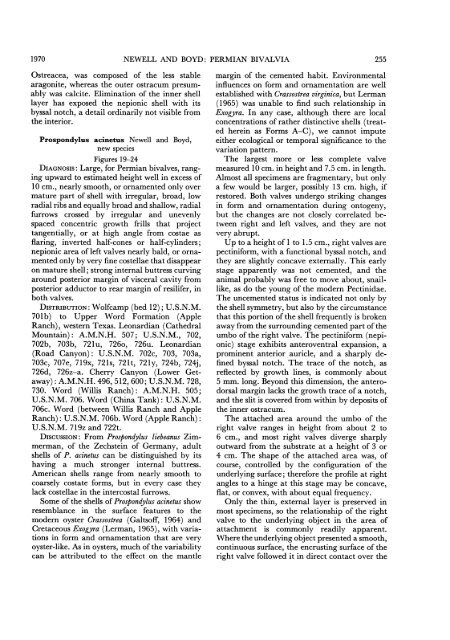IDY TE1>t' I- - American Museum of Natural History
IDY TE1>t' I- - American Museum of Natural History
IDY TE1>t' I- - American Museum of Natural History
You also want an ePaper? Increase the reach of your titles
YUMPU automatically turns print PDFs into web optimized ePapers that Google loves.
1970 NEWELL AND BOYD: PERMIAN BIVALVIA<br />
255<br />
Ostreacea, was composed <strong>of</strong> the less stable<br />
aragonite, whereas the outer ostracum presumably<br />
was calcite. Elimination <strong>of</strong> the inner shell<br />
layer has exposed the nepionic shell with its<br />
byssal notch, a detail ordinarily not visible from<br />
the interior.<br />
Prospondylus acinetus Newell and Boyd,<br />
new species<br />
Figures 19-24<br />
DIAGNOSIS: Large, for Permian bivalves, ranging<br />
upward to estimated height well in excess <strong>of</strong><br />
10 cm., nearly smooth, or ornamented only over<br />
mature part <strong>of</strong> shell with irregular, broad, low<br />
radial ribs and equally broad and shallow, radial<br />
furrows crossed by irregular and unevenly<br />
spaced concentric growth frills that project<br />
tangentially, or at high angle from costae as<br />
flaring, inverted half-cones or half-cylinders;<br />
nepionic area <strong>of</strong> left valves nearly bald, or ornamented<br />
only by very fine costellae that disappear<br />
on mature shell; strong internal buttress curving<br />
around posterior margin <strong>of</strong> visceral cavity from<br />
posterior adductor to rear margin <strong>of</strong> resilifer, in<br />
both valves.<br />
DISTRIBUTION: Wolfcamp (bed 12); U.S.N.M.<br />
701b) to Upper Word Formation (Apple<br />
Ranch), western Texas. Leonardian (Cathedral<br />
Mountain): A.M.N.H. 507; U.S.N.M., 702,<br />
702b, 703b, 721u, 726o, 726u. Leonardian<br />
(Road Canyon): U.S.N.M. 702c, 703, 703a,<br />
703c, 707e, 719x, 721s, 721t, 721y, 724b, 724j,<br />
726d, 726z-a. Cherry Canyon (Lower Getaway):<br />
A.M.N.H. 496, 512, 600; U.S.N.M. 728,<br />
730. Word (Willis Ranch): A.M.N.H. 505;<br />
U.S.N.M. 706. Word (China Tank): U.S.N.M.<br />
706c. Word (between Willis Ranch and Apple<br />
Ranch): U.S.N.M. 706b. Word (Apple Ranch):<br />
U.S.N.M. 719z and 722t.<br />
DIscUSSION: From Prospondylus liebeanus Zimmerman,<br />
<strong>of</strong> the Zechstein <strong>of</strong> Germany, adult<br />
shells <strong>of</strong> P. acinetus can be distinguished by its<br />
having a much stronger internal buttress.<br />
<strong>American</strong> shells range from nearly smooth to<br />
coarsely costate forms, but in every case they<br />
lack costellae in the intercostal furrows.<br />
Some <strong>of</strong> the shells <strong>of</strong> Prospondylus acinetus show<br />
resemblance in the surface features to the<br />
modern oyster Crassostrea (Galts<strong>of</strong>f, 1964) and<br />
Cretaceous Exogyra (Lerman, 1965), with variations<br />
in form and ornamentation that are very<br />
oyster-like. As in oysters, much <strong>of</strong> the variability<br />
can be attributed to the effect on the mantle<br />
margin <strong>of</strong> the cemented habit. Environmental<br />
influences on form and ornamentation are well<br />
established with Crassostrea virginica, but Lerman<br />
(1965) was unable to find such relationship in<br />
Exogyra. In any case, although there are local<br />
concentrations <strong>of</strong> rather distinctive shells (treated<br />
herein as Forms A-C), we cannot impute<br />
either ecological or temporal significance to the<br />
variation pattern.<br />
The largest more or less complete valve<br />
measured 10 cm. in height and 7.5 cm. in length.<br />
Almost all specimens are fragmentary, but only<br />
a few would be larger, possibly 13 cm. high, if<br />
restored. Both valves undergo striking changes<br />
in form and ornamentation during ontogeny,<br />
but the changes are not closely correlated between<br />
right and left valves, and they are not<br />
very abrupt.<br />
Up to a height <strong>of</strong> 1 to 1.5 cm., right valves are<br />
pectiniform, with a functional byssal notch, and<br />
they are slightly concave externally. This early<br />
stage apparently was not cemented, and the<br />
animal probably was free to move about, snaillike,<br />
as do the young <strong>of</strong> the modern Pectinidae.<br />
The uncemented status is indicated not only by<br />
the shell symmetry, but also by the circumstance<br />
that this portion <strong>of</strong> the shell frequently is broken<br />
away from the surrounding cemented part <strong>of</strong> the<br />
umbo <strong>of</strong> the right valve. The pectiniform (nepionic)<br />
stage exhibits anteroventral expansion, a<br />
prominent anterior auricle, and a sharply defined<br />
byssal notch. The trace <strong>of</strong> the notch, as<br />
reflected by growth lines, is commonly about<br />
5 mm. long. Beyond this dimension, the anterodorsal<br />
margin lacks the growth trace <strong>of</strong> a notch,<br />
and the slit is covered from within by deposits <strong>of</strong><br />
the inner ostracum.<br />
The attached area around the umbo <strong>of</strong> the<br />
right valve ranges in height from about 2 to<br />
6 cm., and most right valves diverge sharply<br />
outward from the substrate at a height <strong>of</strong> 3 or<br />
4 cm. The shape <strong>of</strong> the attached area was, <strong>of</strong><br />
course, controlled by the configuration <strong>of</strong> the<br />
underlying surface; therefore the pr<strong>of</strong>ile at right<br />
angles to a hinge at this stage may be concave,<br />
flat, or convex, with about equal frequency.<br />
Only the thin, external layer is preserved in<br />
most specimens, so the relationship <strong>of</strong> the right<br />
valve to the underlying object in the area <strong>of</strong><br />
attachment is commonly readily apparent.<br />
Where the underlying object presented a smooth,<br />
continuous surface, the encrusting surface <strong>of</strong> the<br />
right valve followed it in direct contact over the
















